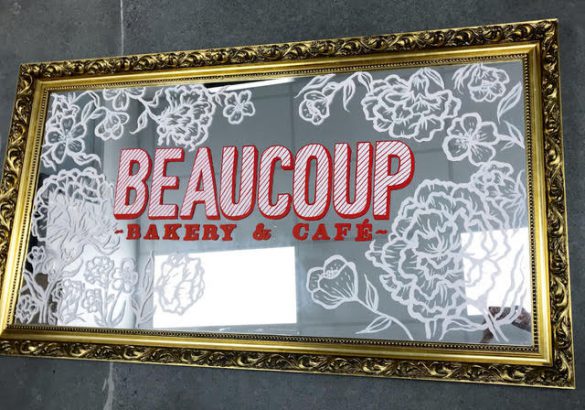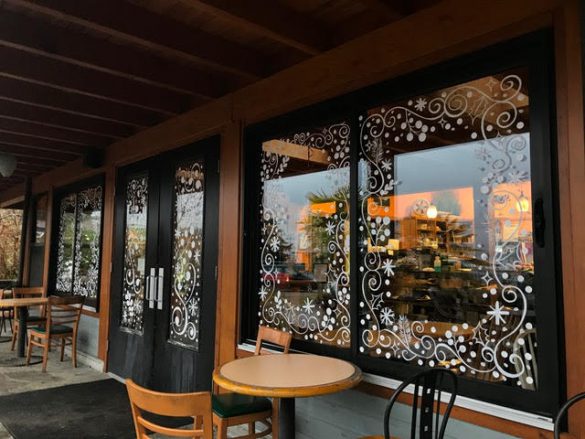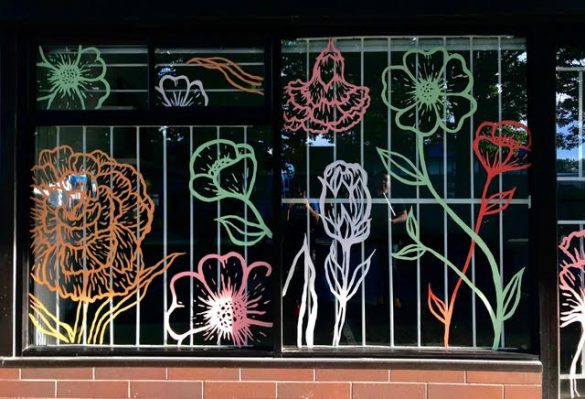A Japanese-Canadian artist based in Vancouver, BC. Her work merges traditional Western art with a neon palette inspired by her Japanese youth. In November 2019, Tiffany started creating window art to scramble back from a medical lay-off. This led her to the concept of creating old school window paintings that are seasonal and unique to each storefront. She made window art throughout Powell River during the busy Christmas season and decided she would bring her services to Vancouver in the Spring.
Unfortunately in the age of COVID she hasn’t had much opportunity to paint as much seasonal art as she would like to. Yet despite this economic low she started painting signs to help businesses update their storefronts to constant change. This has been significant as it’s given Tiffany the opportunity to adapt alongside her city in a positive way. Additionally she strives to maintain a sense of festivity on storefronts in order to brighten up a person’s walk to school or work. Young BIPOC artists come to Tiffany and asking her how she got started with window art and murals. Ricepaper interviewed Tiffany as part of its Artist Profiles series.
Ricepaper: How did you hear about Ricepaper Magazine and why did you join it?
Tiffany: The first time I heard of Ricepaper was when I was fourteen and my mom took me to Powell Street Festival. While wandering around I grabbed a random magazine from the literary booth and took it home. After browsing through Ricepaper I realized I had actually grabbed a manual to make sense of the whole Japanese-Canadian thing. I later became an illustrator for Ricepaper because I wanted to make art for confused half asians like me.
Ricepaper: Can you tell us how it’s given you the opportunity to adapt alongside your city in a positive way?
Tiffany: Although these have been really tough times I refuse to lay down and give up. Instead I adapt and I make that apocalypse economy work for me ! . The way I’ve done this is by offering sign art for storefronts throughout Vancouver. So far I’ve created hand painted signs for stores that want to highlight their new COVID hours or instructions for Takeout. Together we’re turning this negative into a positive by swimming through the muck until we reach dry land.
Ricepaper: Your art features a blend of humour, art and music. Can you share how you’ve been able to use this approach during this difficult time?
Tiffany: When my sister became epileptic our life became scary and unpredictable with the severity of each seizure. However each time my sister came to she’d ask what happened and I’d say “ You made a seizure salad.” Then we’d burst out laughing because dark humour is the best humour. I find that combating trauma with a joke is the only way I know how, and it’s why I like to make funny and colourful art. My thinking is that for every scary news story that gets shoved out into the world maybe I can share something that leaves people feeling aright.
Ricepaper: You identify as Japanese-Canadian. How has your background informed your art? And your perspective on life?
In Vancouver I grew up in my mom’s Japanese home watching Crayon Shin-Chan, drawing manga and eating gumi candies. On weekends and major holidays I magically transformed into a white granddaughter for my dad’s Catholic and European family. Although I grew up with a lot of identity issues I realize my two backgrounds have greatly impacted who I am at my core; a Japanese Catholic girl with so much shame! As far as my perspective on life goes I’ve learned that there’s no proper way to live this life. There’s no religion, political view, or nation that does it right, there’s only common decency.
Ricepaper: You get a lot of young BIPOC folks coming up to you and asking me how you got started with window art and murals. What advice would you give to these artists?
Tiffany: If they’re in Vancouver I tell them to study Fine Art at Langara College. The classes are small and it’s a no B.S. condensed art program that’s very hands on. The next thing I’d say is that there’s no shame in doing commercial art. When times got tough artists like Georgia O’Keefe, Henri de Toulouse-Lautrec, and Norman Rockwell all did commercial art. I say this because BIPOC kids mostly come from low income homes thinking art on Instagram that sells for thousands of dollars is ‘making it’. What they don’t realize is that privilege is a head start and it’s a lot harder to ‘make it’ if you don’t have it. That’s why BIPOC kids need to hustle and find creative ways to pay the rent. In my case I chose window paintings so I didn’t have to get yelled at like a human vending machine at a third wave cafe.








